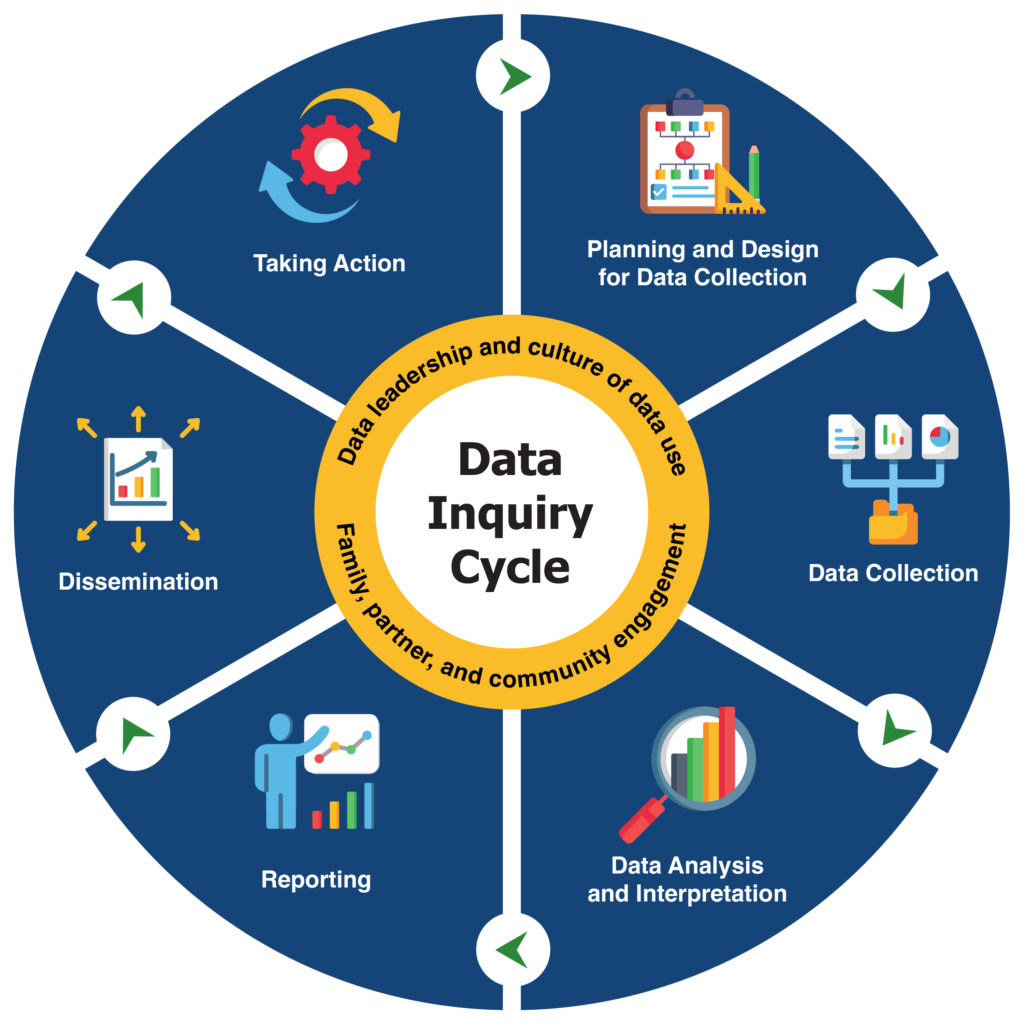Author: Howard Morrison
Are you looking to address disparities in early intervention and early childhood special education systems and promote more equitable practices and outcomes? Or maybe you want to take action on the data submitted by localities and review it by race, ethnicity, gender, language, income, region, or zip code. Knowing where to start can be challenging, but taking one step forward and starting is critical. The DaSy Center developed a guide, DaSy Data Inquiry Cycle, to support Part C and Part B 619 program staff in addressing equity considerations at each stage of the data inquiry cycle.
View the Data Inquiry Cycle and Essential Conditions for Embedding Equity

The data inquiry cycle is an iterative sequence of six stages: planning and design for data collection, data collection, data analysis and interpretation, reporting, dissemination, and taking action. Each stage provides details on what the stage is and provides example considerations for states to consider so they can begin to embed equity into each one. The data inquiry cycle is not a linear process, but an iterative process that states can enter at any point and choose to go through one or multiple stages.
For each stage, identifying and establishing a diverse data team that includes parents, families, partners, and community members that represent a variety of lived experiences, perspectives, and backgrounds is a critical step. Remember: we all have blind spots. Having team members with different lived experiences can shed new light, perspectives, and ideas. For additional support, check out the Stakeholder Knowledge Toolkit.
“We really want to get to that piece where they’re taking action, talking with their state teams about what are they seeing when they look at the data. Are they seeing any inequities about children that are accessing services, and how does that look when it’s being broken out by race, ethnicity? And what community partners do we need to bring in to have those conversations to get deeper into the story about what’s actually happening? And so the product (Embedding Equity in the Data Inquiry Cycle) is really a tool for states to take and be able to meet with their teams and say, “Oh, we could take this kind of tip in consideration and integrate that into our daily practice.”
–Howard Morrison, Dasy TA Liaison. The SRI Homeroom, Using Data to Improve Early Childhood Equity.
To successfully embed equity into everyday data practices, DaSy has identified three essential conditions for the data inquiry cycle:
- Data leadership
- Culture of data use
- Family, partner, and community engagement
It is not required to have all these conditions in place to start. However, Part C and B 619 program staff should apply these essential conditions as an ongoing process and continue to build upon them over time and embed them into their routine internal and partner meetings.
It’s not unusual for someone to think, “I don’t know, do, or understand data.” We want to shift that narrative to enhance data leadership and encourage a culture of data use. We all have the capacity to engage, connect with colleagues with strong data skills, and have discussions about the data relevant to our content areas. Visit the Data Culture Toolkit for additional resources and support.
Take a Step Forward into Any Stage
Start by identifying what policy or critical questions you want to answer or address. For examples, visit DaSy’s Critical Questions About Early Intervention and Early Childhood Special Education or Critical Questions for Addressing Racial Equity in Early Intervention and Early Childhood Special Education. Then decide where on the data inquiry cycle you want to start. If it’s “taking action,” review the summary in the guide and discuss how the considerations may be used and leveraged in your team’s planning.
You Don’t Need to Do This Alone
Be sure to reach out to the DaSy Center for help. We are here to help you plan, implement and support you at each stage of the data inquiry cycle as well as supporting developing or enhancing your essential conditions. You can also access additional resources below.
Resources
- DaSy Data Framework
- Critical Questions About Early Intervention and Early Childhood Special Education
- Critical Questions for Addressing Racial Equity in Early Intervention and Early Childhood Special Education
- DaSy Data Culture Toolkit
- Data Leadership Competencies for Part C and Part B 619
- Stakeholder Knowledge Toolkit
- Look! Think! Act! Using Data for Program Improvement
- Podcast: Using Data to Improve Early Childhood Equity
About the Authors

Howard Morrison is a DaSy Technical Assistance Specialist with SRI. Howard specializes in early childhood education on a variety of topics, data linking and integration, data use, data governance, data sharing agreements, school readiness, public-private partnerships, community engagement, and state systems. He has worked on several large national TA projects, developing resources and leading TA efforts.
Published May 2024.


